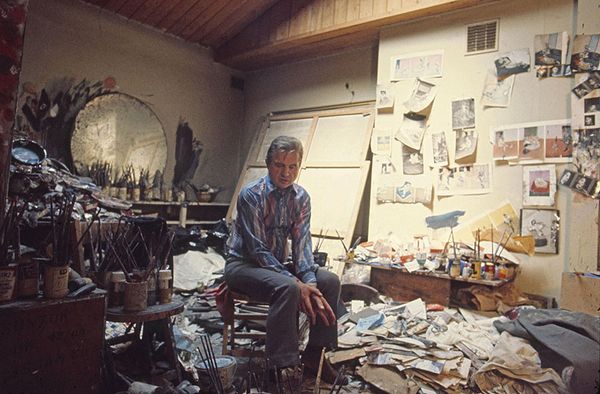Michael Holtz, Francis Bacon in his 7 Reece Mews Studio, 1974. © Michael Holtz/ Photo 12/ Alamy.
The art critic John Russel once discussed an indescribable yet "irreducible Baconian element" that set the work of Francis Bacon apart from the rest. This uniquely compelling force permeates Bacon’s entire oeuvre – it is "something put into painting by Bacon and nobody else." Although this "Baconian element" remains undefinable, the palpable presence of Bacon himself in the work is doubtlessly a fundamental aspect. Like a mirror, his art reflects his inner psyche. By combining aspects of his own biography with religious and mythological motifs, Bacon’s paintings and prints encapsulate his preoccupations with self-interrogation and the fickleness of human mortality. In so doing, his images mirror not only his personal ruminations on life, but also the viewers’ idiomatic experiences and universal anxieties felt throughout society.
When you paint anything, you’re also painting yourself, as well as the object you’re trying to record.
-Francis Bacon
In April 1945, one month before the end of World War II, Francis Bacon’s Three Studies for Figures at the Base of a Crucifixion went on view at the Lefevre Gallery on New Bond Street. It depicts three distorted figures – part man, part beast – roaring with distress and pulsing with rage before a cadmium orange background. Bacon identified these figures as Greek furies – the vengeful, ancient goddesses who punished human wrongdoings. In Deuxième version du triptyque, Bacon adopts motifs from classical Greek tragedy and places them within the configuration of a triptych, evoking dark and foreboding themes that have timeless pertinence. The work was borne from a very specific moment – the first photographs and films from inside Nazi concentration camps were being revealed to the world, and nuclear destruction was an imminent threat. Born in 1909, Bacon had lived through both World Wars and had experienced the tragedy of warfare. The furies embody this collective trauma: their gaping mouths, exposed ribs and tortured cries voice the anguish felt by a society that had endured unspeakable pain.
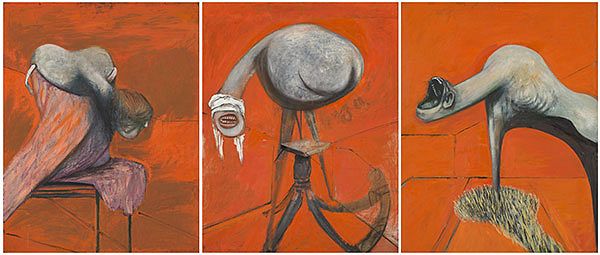
Francis Bacon, Three Studies for Figures at the Base of a Crucifixion, 1944. Image © Tate, Artwork © The Estate of Francis Bacon. All rights reserved. DACS 2021.
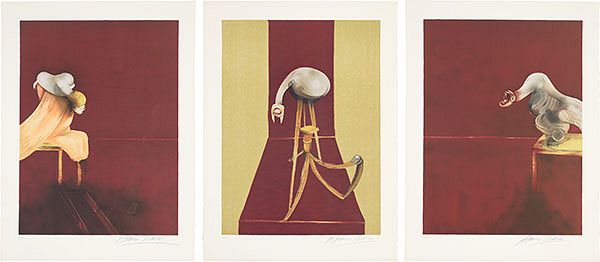
Francis Bacon, Deuxième version du triptyque, 1989. Editions London.
Far from being diminishing, the poignancy and potency of Bacon’s Three Studies only gained momentum as the tumultuous twentieth century progressed, and in 1989 he reworked the earlier imagery to create Deuxième version du triptyque [Lot 10]. The same bestial creatures are now set before a violent, blood-red background in an elegant, but no less harrowing, distillation of Bacon’s earlier version. The sense of isolated, inner pain is heightened by the small, bare interiors in which his figures are situated. These impersonal, cell-like rooms became a central construction in Bacon’s work. Whereas in 1945, Bacon’s furies consumed the space and burst forth from their confines, the figures in the later triptych are considerably shrunken and constrained in relation to their surroundings. The claustrophobia of the earlier work has developed into a helpless seclusion, bringing universal suffering to an individual level and evoking the torment of being caged in the unending cycle of one’s own misery. Despite being both animalistic and mythological creatures, the beasts express human emotions with a mortal intensity that reveal the inclinations of the artist. This pain is reflected back on the viewer and they are forced to examine their own distress.
Animals are another motif to which Bacon returned prolifically, and this will be explored in the upcoming Royal Academy, London, exhibition titled Francis Bacon: Man and Beast, opening in January 2022. As a racehorse trainer and passionate hunter, Bacon’s father raised him with an awareness of the violence associated with animal husbandry, which is present throughout Bacon’s imagery. Deuxième version du triptyque, for instance, subverts traditional depictions of furies and does not visualise them as elegant, winged female deities. Instead, Bacon butchers them into monstrous hybrids. Perched on flimsy wooden furniture, their extended necks, exposed ribs and oversized jaws evoke ravenous vultures, writhing and wailing with anger and pain. Bacon conceived of animals as a living commentary on our own species and a reminder that humanity’s primal instincts do not lie far beneath the surface. Therefore, as well as being captivated by the ferociousness of these beastly others, he was deeply concerned with the animality of people. Bacon felt that Rembrandt’s portraits of others were more insightful of the artist himself, and the same can be said for Bacon’s studies of animals.
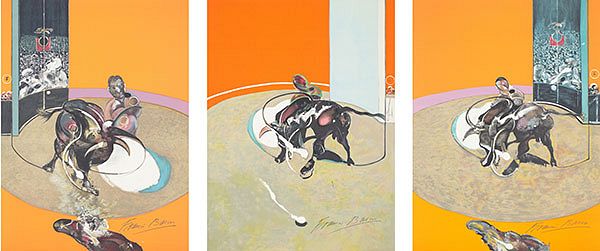
Francis Bacon, Miroir de la tauromachie, 1990. Editions London.
This sense is crystalized in Bacon’s trio of bullfight studies, which are offered in the upcoming sale under the title Miroir de la tauromachie [Lot 7]. The works will also be the highlight of the Royal Academy exhibition, where the three painted studies will be reunited for the first time. They each depict an ominous bull with monstrous horns charging at the matador in the center of the bullring. Contained in a fiery orange interior, the bull and matador are rendered in a painterly application of bruise-like tones that unite them and express the intensity between man and beast. Despite the pomp, grandeur and macho prestige associated with bullfighting as a spectator sport, it is also an embodiment of the capricious mortality. The matador repeatedly faces death head-on, while maintaining a fearless confidence in his ability to defy it. Man and beast, entwined in Bacon’s composition, illustrate the flimsy boundaries between humanity and animality, and between life and death.
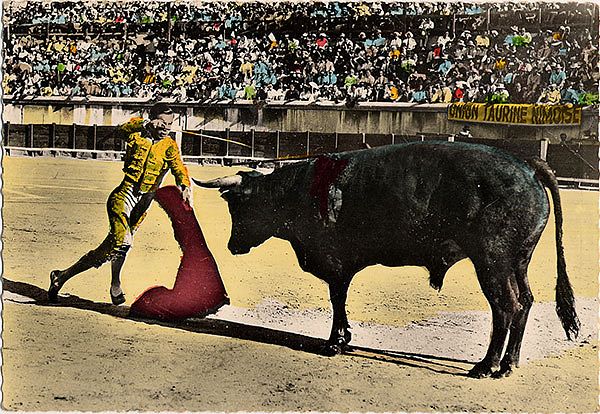
Postcard of a matador and bull, found in Francis Bacon’s studio. Image © Hugh Lane Gallery, Dublin (Reg. No. RM98BC5) © Estate of Francis Bacon. All rights reserved. DACS 2021.
Inspired by the French Surrealist Micheal Leiris’ 1938 text, Miroir de la tauromachie, the presence of mirrors in Bacon’s studies of bulls enforces the composition’s searing sense of self-examination. Rather than being located in a plaza de toros packed with passionate spectators, the bullfight takes place in a staged interior that is empty apart from a single mirror. In two of the studies, crowds of people can be seen in the reflection. However, the blank mirror in the central study implies that those crowds are in the figures’ imagination. The matador and bull are not fighting to the death for the entertainment and pleasure of the viewer, but rather because their primal instincts demand the deadly battle. The mirrors allude to both the imaginary crowd of spectators and also the single viewer, confronting them with their voyeuristic enjoyment of this gruesome dual.
We are all animals if you care to think about it. It’s just that some people are more aware of the fact than others. I think I’ve been very aware of it ever since I was a child.
- Francis Bacon
Bacon’s close affinity to the bull grew as he became older, and he returned to the motif multiple times. A bull was the subject of his last painting ever made, Study of a Bull, 1991 – a haunting image of a ghostly bull traversing from a black abyss to a field of glowing white. Also, he was recalled by the nuns that nursed him on his deathbed in Madrid to have spent his final days sketching bulls.
In the later period of his life, Bacon turned his artistic eye inwards once more, undertaking his most prolonged and prolific period of self-portraiture – it is in these works that the intensity of his self-rumination reaches its zenith. The fragility of human life became particularly undeniable to Bacon in the 1970s after many of his close friends passed way within a short period of time. In 1975 Bacon said "I loath my own face… I’ve done a lot of self-portraits, really because people have been dying around me like flies and I’ve nobody else to paint but myself." In the almost obsessive period of self-portraiture that followed, Bacon would endure hours of close self-examination from either photographs of himself or from staring in the mirror. Unavoidably aware of his own mortality, the works are highly analytical investigations into Bacon’s inner psyche and his fear and fascination of death and decay.
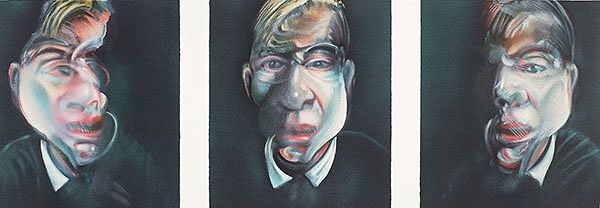
Francis Bacon, Trois études pour un autoportrait (after, Three Studies for a Self-portrait 1979), 1981. Editions London.
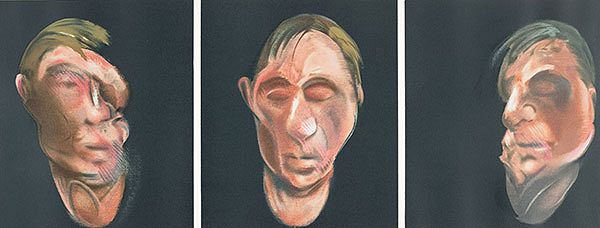
Francis Bacon, Trois études pour un autoportrait (after, Three Studies for a Self-Portrait 1983), 1990. Editions London.
In Trois études pour un autoportrait [Lots 11 & 12] the self-portraits are placed in a triptych configuration. They depict Bacon’s face from shifting perspectives against a flat black abyss, illuminated in three disparate flash-bulb moments. His features both emerge from and are invaded by the surrounding void of darkness, the ambivalence of which evokes a dizzying sense of motion. Far from being comprised of three disparate works, the triptych presents sequential and interconnected images that constitute a cohesive, almost panoramic portrait of the artist. Blurred and distorted, the restlessness of the composition elicits a sense of psychological distress in the subject. The figure’s commanding physical presence does not disguise the volatility effused by the varying perspectives, and the mercurial rendering of paint summons an unwavering acknowledgement of the fleeting nature of human life. The level of criticism that Bacon applied to himself through his work is palpable in his abstract rendering of flesh, which he often referred to as "injuring." In the central panel, the artist’s melancholic face is positioned directly front-on to the viewer, reflecting not the viewer’s likeness but the viewer’s inner anxieties and awareness of their own psychological strife. In this way, the works are windows that reveal an undeniable existential truth about the human condition.
The "irreducible Baconian element" remains an ineffable and impalpable force. But, a fundamental aspect lies in the transfusion of Bacon’s inner psyche and his obsessive preoccupation with mortality into his art. Like a mirror image, the works are imbued with a tangible sense of the artist’s innermost emotions, and this is reflective of anxieties that have universal resonance. As Michel Leiris described, Bacon’s artworks are "mythic translations of our inward structure which move us to the extent to which they throw light on ourselves." In their deep introspection and searing self-examination, Bacon’s works are hauntingly poignant as they distill humanity’s most salient emotions. In this way, they are mirrors of the soul that reflect the viewer as much as they do the artist.
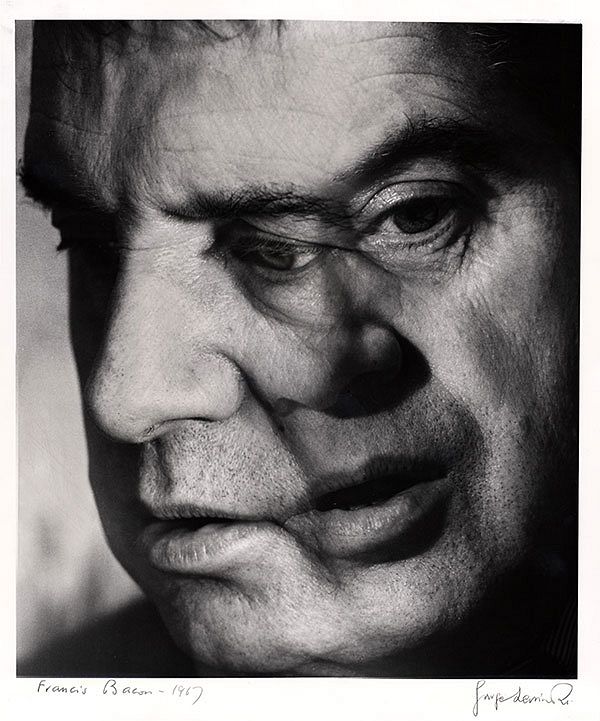
Jorge Lewinski, Francis Bacon, 1967. © The Lewinski Archive at Chatsworth/Bridgeman Images.
Recommended Reading
